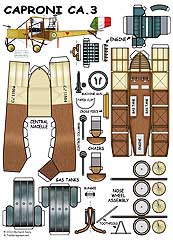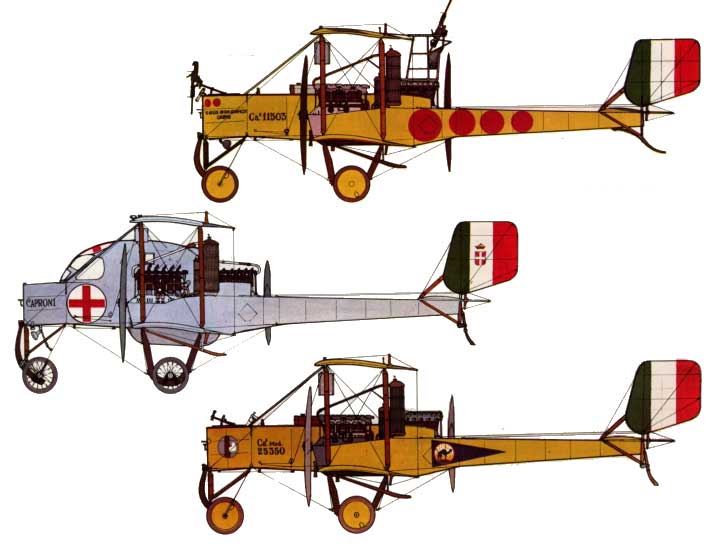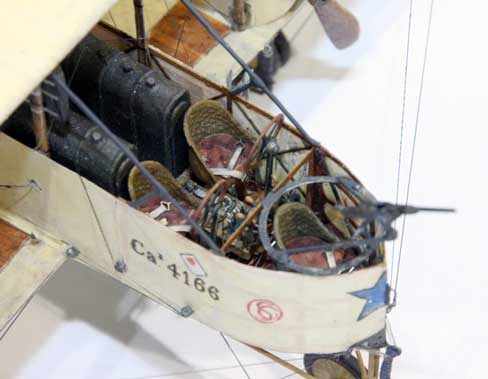


Caproni-Ca3 - $$14.95
Besides Russia, Italy was the only power which believed in the usefulness of heavy strategic bombers as far back as the beginning of the War to End ALL Wars. This Ca-3 outfitted 12 squadrons of the Aeronautica Militare at the end of 1916. It had a brave crew of 4 and a 1000 pound bomb capacity
Caproni C-3 WWI Bomber


Italy; First in Air War...
Italy was the first country in the field of military aeronautics, having established an Army Aeronautical Section equipped with balloons as early as 1884. and it was also the first country to drop bombs on an enemy during war. This was on November 1, 1911. during the Italo-Turkish war. when Lt Gavotti dropped four grenades of 4.1 lb each on Turkish troops in Libya. Further raids followed causing more annoyance than damage. Then the Turks protested that an Italian aircraft had bombed a military hospital at Ain Zara and an immediate controversy arose in the Italian.
Turkish and neutral Press
At that time there was no independent way of establishing whether a hospital had actually been bombed and the Italians reasonably pointed out that no similar protest had been made when their warships shelled Ain Zara a few days earlier. But many felt there was something particularly inhuman about aerial bombs and the controversy about the subject has continued ever since.
When Italy entered the war in May 1915 against Austria and Hungary, her Army Air Service was perhaps more highly trained than any other and in an excellent state of readiness. This was offset to some extent by the fact that most of her 150 aircraft were French types such as Nieuport and Bleriot monoplanes and Maurice-Farman pusher biplanes. already out-dated.
The first bomber to be built in quantity for the Italian Army Air Service was the Ca 12. in which the rotary engines were replaced by three Fiat inline water-cooled engines of 100 hp each. Deliveries began within three months of Italy's declaration of war and went into action almost immediately. They were easy to handle, had an excellent range. and could carry up to 1.000 lb of bombs.
The development of the Ca.1 to the Ca.2 suggested the benefits of increasing amounts of power to the very sound airframe. The Ca.3 was a development of Ca.2, by replacing the two engines mounted on the booms with the same Isotta-Fraschini engine that had been used as the central, pusher engine on that design.
The series began in 1913 with the Ca 30 powered by three Gnome rotary engines one of which was mounted as a pusher in the central nacelle while the other two drove. indirectly, two tractor propellers in twin fuselage booms. The indirect drive was not successful and was abandoned in the Ca 31. the outer pair of engines being re-located at  the front of the booms. This became the standard configuration for the series.
the front of the booms. This became the standard configuration for the series.
The Caproni Ca 30/33 series (our model!) which, together with the Russian Il'ya Muromets, were the first very large planes built. These certainly gave Italy the lead in heavy bombing during the early part of the war. The prototype flew in late 1916 and was soon put into production. Known to Caproni at the time as the Caproni 450 hp, the Italian Army designated it the Ca.3. In Caproni's post-war redesignation, it became the Ca.33. Somewhere between 250 and 300 of these aircraft were built, supplying the Italian Army and Navy (the latter using the type as a torpedo bomber), and the French Army. Late in the war, Robert Esnault-Pelterie built the type under licence in France, building an additional 83 (some sources say only 19) aircraft.The Ca 33 version was soon put into production with a multl-wheel landing gear configuration for operations from rough battle fields. It featured TWO gun positions- one in the front cockpit and the other in the rear. The two pilots sat side by side. This type was so popular it was also built under license in France.
These certainly gave Italy the lead in heavy bombing during the early part of the war. The prototype flew in late 1916 and was soon put into production. Known to Caproni at the time as the Caproni 450 hp, the Italian Army designated it the Ca.3. In Caproni's post-war redesignation, it became the Ca.33. Somewhere between 250 and 300 of these aircraft were built, supplying the Italian Army and Navy (the latter using the type as a torpedo bomber), and the French Army. Late in the war, Robert Esnault-Pelterie built the type under licence in France, building an additional 83 (some sources say only 19) aircraft.The Ca 33 version was soon put into production with a multl-wheel landing gear configuration for operations from rough battle fields. It featured TWO gun positions- one in the front cockpit and the other in the rear. The two pilots sat side by side. This type was so popular it was also built under license in France.
Note: there is some variation in published sources over early Caproni designations. The confusion stems, in part, from three separate schemes used to designate these aircraft - Caproni's (Portrait right) in-house designations of the time, those used by the Italian Army, and designations created after the war by Caproni to refer to past designs.
All FG kits can be easily enlarged IF the kopy cops at Kinkos will allow you to make a copy |
 |
 Photo taken of a plastic Caproni Ca-3 WWI Italian Bomber |
 Caproni Ca-3 WWI Bomber sketch of the cockpit |
 Caproni Ca-3 WWI Italian Bomber and ground crew. A lovely diorama |
|
 The Caproni Ca-3 bomber had massive flying surfaces providing stability but using only about 300 hp, it flew very slowly |
 That plastic model from a little different angle. Detailing on the Ca-3 is quite basic and easy- even the engines !! |
|
|
 |
Caproni Ca-4 (1917) Basically very similar to the Ca-3 but different in that it was a triplane and was larger. It never completely replaced the biplane which remained in use until the end of the war, but was used with it, mostly in night bombing actions over Austria and the Adriatic coast. 41 Caproni Ca-4's were built. Their 3195 lb bomb capacity made them the most successful heavy bombers of the War to End all Wars. |
Operational History:
The Ca.1 entered service with the Italian Army in the middle of 1915 and first saw action on 20 August 1915, attacking the Austrian air base at Aisovizza. 15 bomber squadrons (1-15 Squadriglia) were eventually equipped with Ca.1, Ca.2, and Ca.3 bombers, mostly bombing targets in Austro-Hungary. The 12th squadron operated in Libya. In 1918, three squadrons (3, 14 and 15) operated in France.
Apart from the Italian Army, Caproni Ca.3s were also used in British squadrons, before the introduction of the Handley Page Type O bombers. Original and licence-built ones were used by France (original Caproni were used in French CAP escadres, licence-built examples in CEP escadres). They were also used by the American Expeditionary Force.
This plane is also remembered for a tragedy on May 4, 1919, which killed the French General Dr. Milan Rastislav Stefanik, who was the minister of war in the Czechoslovak Republic at the time. The accident occurred at the conclusion of a flight to Campo Formido near Udine to Bratislava (capital of Slovakia). On his initial approach, the pilot determined that the ground was too wet to land on, so he increased power to the engines and began to aim the plane to a landing patch further afield which appeared to be dry. While doing so, one of the engines exploded, causing the aircraft to nosedive. General Stefanik and the three Italian crew members were pronounced dead at the scene. A subsequent investigation determined that the most likely cause of engine failure was due to a failure of the air blast cooling of the engine, probably induced by the increased strain cause by the pilot's sudden demands on the engine after the aborted landing.
There were allegations that a Czech anti-aircraft artillery company had fired on the craft, either because they mistook the plane's Italian markings for Hungarian markings or that they had done so as part of a conspiracy to see Gen. Stefanik killed in order to prevent him from putting forth proposed changes in the Czech government. These allegations were never proven, and the failure of the engine's blast cooling is widely accepted as the best explanation for the accident.
 |
|||
The Ca.3 was a three-engined biplane of wooden construction, with a fabric-covered frame. |
The crew of four was placed in an open central nacelle (front gunner, two pilots and rear gunner-mechanic). 1764 lbs (max) of bombs were suspended under the hull. The CA3 had a ceiling of only about 16,000 ft |
The rear gunner manned upper machine guns, standing upon the central engine in a protective "cage", just in front of a propeller. wow!! |
Three vertical fins controlled yaw very well. The alternate would have been fewer surfaces BUT a longer fuselage |
Tricycle landing gear with 10 large diameter wheels gave the Ca-3 great rough field capabilities.
(right) The Caproni's wings (74'7") had an aspect ratio comparable to that of a glider !! |
 The Ca-3's long wings and ample control surfaces |
Armament consisted of two to four Revelli 6.5 mm or 7.7 mm machine guns, one in front ring mounting and one, two or sometimes even three in an upper ring mounting.
The CA-3 was quite vulnerable from below.
With all these people standing around creating a huge amount of drag, the CA-3 could only reach 85 mph |
|
Just kidding" Richard Dery, May 19, 2012 |
|
What makes Fiddlersgreen models the very best anywhere is the copyrighted and formatted instruction sheet. Simple, informative, and understandible to everyone ...English speaking or not. Our world class designers, and Richard is a prime example, are top notch sculptors/artists/cartoonists as well as having a fun sense of humor. FG is so lucky to have them chip |



 What a perfect model park Flyer with the batteries right over the C/G where the Ca-3's fuel tanks are.
What a perfect model park Flyer with the batteries right over the C/G where the Ca-3's fuel tanks are.



